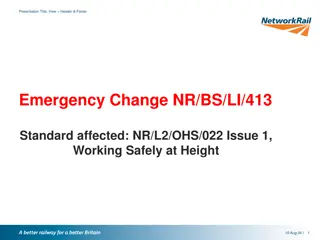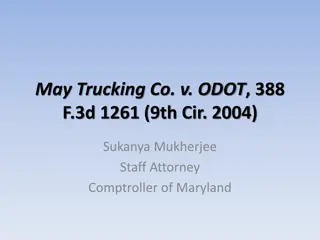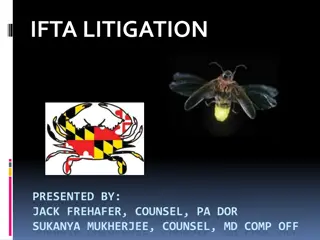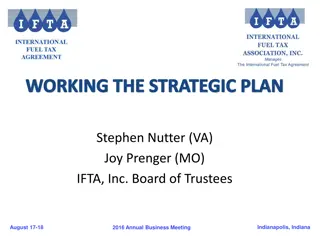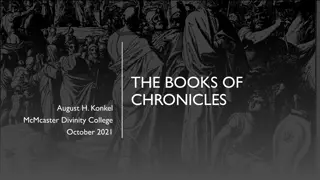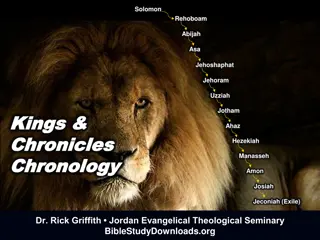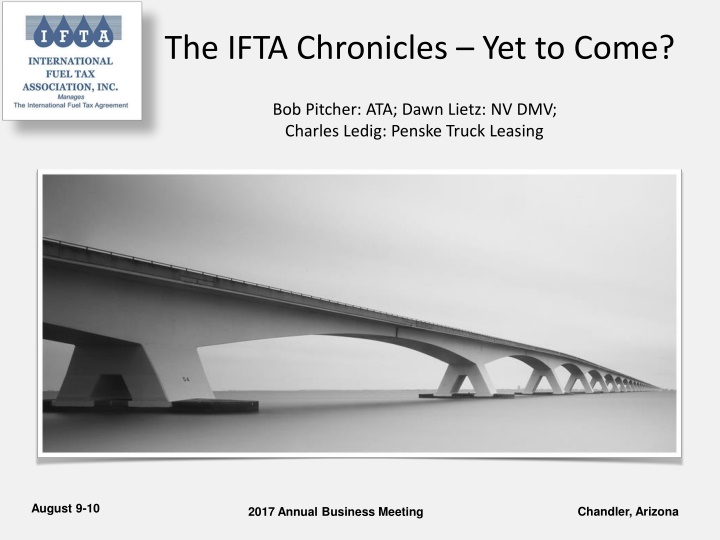
Innovations from 1983: Millennials, IFTA, and Technology Advances
Exploring the parallel evolution of Millennials, the International Fuel Tax Agreement (IFTA), and technological advancements since 1983. Contrasting how Millennials readily adapt to new technologies while IFTA faces challenges in implementing changes. Overview of autonomous vehicles and the stages of automation.
Download Presentation

Please find below an Image/Link to download the presentation.
The content on the website is provided AS IS for your information and personal use only. It may not be sold, licensed, or shared on other websites without obtaining consent from the author. If you encounter any issues during the download, it is possible that the publisher has removed the file from their server.
You are allowed to download the files provided on this website for personal or commercial use, subject to the condition that they are used lawfully. All files are the property of their respective owners.
The content on the website is provided AS IS for your information and personal use only. It may not be sold, licensed, or shared on other websites without obtaining consent from the author.
E N D
Presentation Transcript
The IFTA Chronicles Yet to Come? Bob Pitcher: ATA; Dawn Lietz: NV DMV; Charles Ledig: Penske Truck Leasing August 9-10 Chandler, Arizona 2017 Annual Business Meeting
A COMMON LINK What do and and Have in common? 1983
Millennials First millennials graduated high school in 2000 Age range approximately: 17 34 By 2030 will make up about 50% of US workforce Majority believe technology makes life easier Civic-minded: Strong sense of community Very confident: Taught there is nothing they cannot accomplish
IFTA Founded 1983: ISTEA 1991: Mandated membership by Sept 1996 Current Membership: 1996 (includes 48-Contiguous US States and 10 Canadian Provinces)
Evolution of the Cell Phone 1983 (1G) Talking 1992 (2G) SMS (text) 1996 Internet 1999 Media (WAP) 2001 (3G) in Japan 2002 MM and Camera (sold US) 2003 Blackberry (Color screen) 2007 Apple iPhone 2009 (4G/LTE) in US 20xx (5G) early 2020 s 1983 1989 1993 1998 2003 2007 2004
Similarities Debuted in or near 1983 Gained momentum (blossomed) around millennium All are strongly driven by technology advances
Differences Millennials: Adapt and embrace technology changes Willing to pay for latest/greatest technology releases Motivated and challenged by advances in technology IFTA: Dependent upon membership to embrace changes Ballots required to adopt change Programming costs hinder acceptance of changes Mobile technology: Partners with communication networks Fiber Optics/Cell Towers/Satellite Communications High Tech competition spurs new advancements
Stages of Automation Level 0 Human driver in complete control Level 1 Individual controls are automated-Human control Level 2 At least 2 functions automated in unison Level 3 Car is in control Human on standby Level 4 Car drives itself in most environments Level 5 All robot, all the time Human along for the ride
Autonomous Vehicles How might they affect us? -Changes to HOS? -Need for fewer drivers? -Shift from fossil fuels to alternative sources, such as electric/solar? -Greater vehicle efficiency = lower MPG s? - NEED FOR INFRASTRUCTURE CHANGES?
Age of Autonomy By now, we all know about vehicles. But there s more . Objects you ve never even considered will become smart devices - dog collars, coffee makers, windows. It will become a practical necessity for devices to operate autonomously. Craig Macy, CEO of Onstream. Top 8 companies as of December 2015 VIV; Wit.ai; Cohda Wireless; Saffron Technology; IBM Watson Developer Cloud; Edge3 Technologies; B+B SmartWorx; and Filament. Source: https://venturebeat.com/2015/12/12/autonomous-tech-will-surge-in-2016-keep-an-eye-on-these-8-players/
Platooning What is it? Platooning is a convoy of trucks equipped with state-of-the-art driving support systems Uses Vehicle to vehicle (V2V) communication technology to simultaneously brake and accelerate
Platooning What are the benefits? Increases the capacity of roads by decreasing the distance between vehicles Increases road safety Reduces fuel consumption and CO2 emissions Makes good use of autonomous technology
One Companys Brief Perspective The Future of Transportation The Known and Unknown
What We Know Connected Fleets Telematics Big Data Platform Efficient / Effective Operation Route Optimization / Fuel Stop Planning Predictive Vehicle Maintenance Improved Safety
What WeDont Know But Know is Coming Electrification / Alternative Fuels Battery Fuel Cell Platooning Drive Fuel Efficiency Autonomous Vehicles Effective / Efficient Safety
What If?.... Regulatory Environment (EPA, State Gov t, etc.) May Dictate Changes Sooner Than Later? Connected Things Comprehensive Visibility to How Much, When and Where? Single Revenue Source Model Leverage Technology to Evolve / Phase-In Revenue Generation Systems to One Platform? o IFTA; IRP; Base Registration; VMT; Tolling; Etc.
THE FUTURE IS HERE NOW; IT S JUST NOT EVENLY DISTRIBUTED. -- Wm. Gibson
Dividing Up the World Fuel Equipment Labor Investment Freight Roads Regulation Government
FUEL Alternative Fuels or Power Sources Popular Again Once Diesel Goes Up Challenges for Tax Administration Strain on the Fuel Tax?
And a Bit About VMTs Mostly Just a Concept Except for Weight-Distance Taxes Miserable History for W/D Can Technology Fix the Troubles?
Why VMTs Are Not Likely Fuel Taxpayers Number in the Hundreds VMT Taxpayers in the Multi-Millions! Administrative Costs Evasion & Avoidance Privacy Concerns
Equipment Automated Trucks Are Here Now! (Mostly) Autonomous Trucks Will Be Here Soon Autonomous Vehicles Could Change Road Use SIGNIFICANTLY More Stress on Road Funding?
Labor Shortage of Truck Drivers Continues Shortage of Technicians Worsening What Does the Fellow in an AT DO? Different Jobs / Different Mix of Workers
Investment Increasing Regulation, Innovation, Labor Shortages WHERE S THE MONEY GONNA COME FROM? Increase in Freight + Capacity Shortage = Higher Rates Tax Reform?
Freight Much More of It Trucks Will Move It Lighter Loads, Shorter Hauls More Frequent: 3D Printing; the Amazon Model
Roads WHERE S THE MONEY GONNA COME FROM? Changed Configurations for AV? How Will AV Change Road Use?
Regulation Road Taxes? Fuel Tax Good At Least a Decade More ELDs Electronic Records Regulatory Climate Changing?
Government Politics About to Get REALLY Nasty? Strains in Federalism State Pension, Budget Problems Changes in Government Labor Force
What is VMT Vehicle miles of travel or vehicle miles traveled (VMT) is defined by the U.S. government as a measurement of miles traveled by vehicles within a specified region for a specified time period. Information courtesy of Mike Albin - SICPA
Why are States Interested in VMT The American Society of Civil Engineers says our system of roads, bridges, sewers, dams and ports combined, stated that the stimulus package of $700 billion that was passed in 2009 was not enough and will not help the future of maintaining Transportation methods in the US. The Highway Trust Fund in the U.S. is essentially in receivership, until 2017 there was little to no willingness to talk about increasing the fuel tax. The last federal fuel tax increase was in 1993. Last increase was over 24 years ago In 2012 Average miles per gallon was 23.6, in 2016 went up to 24.8 Appears to be a minimal difference, but just over 1 gallon better gas mileage reduces the highway fund between 5%-10% Information courtesy of Mike Albin - SICPA
Are States losing According to the FHWA 3.2 trillion miles were traveled on US roadways in 2016 5th straight year of increased mileage, but this puts more demand on our roadways In 2016 California alone accounted for 13% of all the miles traveled in the US Which means on average approximately each state would represent 1.78% each of total miles remaining. Many states just do not have enough funding to maintain their infrastructure Information courtesy of Mike Albin - SICPA
VMTs - Just more questions Are we are treating VMT as just some big science project and looking the other way when it comes to what is really needed to support a VMT? Do we need to look more closely at alternatives through Vehicle Registration fees or listen to millennials? Do we need to look at other program initiatives for increasing transportation funding for infrastructure renewal programs? Information courtesy of Mike Albin - SICPA
Millennials will change the Future of Transportation The Millennial Generation The largest and most diverse generation in American history 40% of Millennials are African American, Latino, Asian or racially-mixed compared to only 25% of the next two older generations. Millennials are multimodal They choose the best transportation mode (driving, transit, bike, or walk) based on the trip they are planning to take. Public transportation options is the mode of Transportation millennials are choosing Mass Transit allows Millennials to get to work as well as play Rather not be bothered by driving and finding a parking space Reasons and motivations for transportation choices 46% Need to save money for the future - Unlike baby boomers who normally started saving in the mid 30 s 46% convenience - Can stay connected with friends 44% want to go places - like the gym, dinner and vacations and a car could prevent this 35% want to live in a community where it just makes sense to use transit. Information courtesy of Mike Albin - SICPA
Millennials are our future WE MUST LISTEN 61% want more reliable mass transportation systems Compared to 35% of baby boomers 55% want real-time updates Compared to 18% of baby boomers 75% want better/faster Wi-Fi connections Compared to 65% of baby boomers 44% want a less stressful work place Compared to 68% of Baby boomers 48% want more vacation time to travel and see the world Compared to 31% of baby boomers 40% want to own a home Compared to 92% of baby boomers 38% want eat healthy and exercise Compared to 22% of baby boomers 30% want to own at least one television Compared to 91% of baby boomers 30% want to own a car Compared to 89% of baby boomers 34% feel social media is the way to network Compared to 16% of baby boomers Information courtesy of Mike Albin - SICPA
Top 5 modes of transportation for Millennials Information courtesy of Mike Albin - SICPA
The $1,000,000 Question How do we sustain the funding for future highway infrastructure needs? Maintain status quo and rely solely on fuel taxes? VMT s? Virtual Tolling? Parking meters for electric vehicle charging stations? What if hybrid technology is combined with solar? Combination of multiple taxing sources? ??? THE FUTURE IS HERE THE FUTURE IS NOW ARE YOU READY?
Final Thought by Deiter Bohn, The Verge And the thought that kept occurring to me is how little everybody knew about what was about to happen to the smartphone industry before the iPhone came along. Nobody knew what they didn t know.











